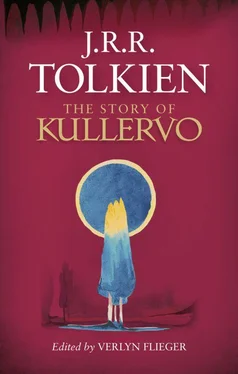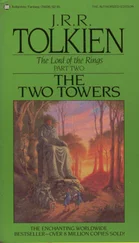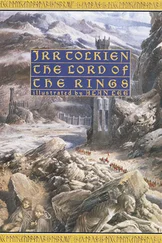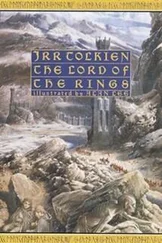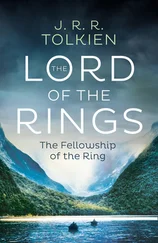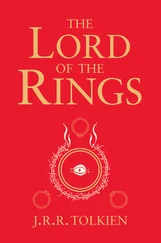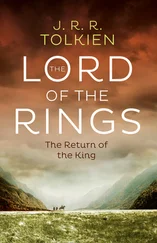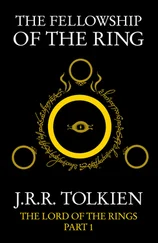[Jumala, whose name translates God in the Bible, is still in the Kalevala the God of clouds and rain, the old man of the sky, the guardian of the many Daughters of Creation] — It is very parallel to the interest of Icelandic Bishops in the adventures [of] Thórr and Óðinn; it is hardly an instance as I have heard claimed, of the still-struggling presence of paganism in Modern Eur[ope] under layers of Christianity or later of Hebraic biblicality. Even when collected and at last suffering the fate of reproduction in print these poems by luck escaped being handled roughly or moralistically: it is a startling litterature to be so popular among that now most law-abiding and most Lutheran of Europe’s peoples.
III
The language of these poems, Finnish, makes a strong bid for the place of most difficult in Europe: though it is anything but ugly, in fact it suffers like many lang[uages] of its type from an excess of euphony: so much so that the music of language is apt to be expended automatically and leave no excess with which to heighten the emotion of a lyric passage. Where vowel harmony and the softening of cons[onants] is an integral part of ordinary speech, there is less chance for sudden unexpected sweetnesses. It is a language practically isolated in Europe except for the related and neighbouring Estonia whose stories and whose tongue are very closely akin. (I am told it bears relation to tribal speeches in Russia, to Magyar, to Turkish in the far distance.) It bears no relation to either of its neighbours except in process of borrowing: it is too a language of a type altogether more primitive than most in Europe. It still partakes of a flexible fluid unfixed state inconceivable in English. In the poetry meaningless syllables and even meaningless words that just sound jolly are freely inserted. In such lines as
‘Enkä lähe Inkerelle
Penkerelle Pänkerelle’
or
‘Ihveniä ahvenia
Tuimenia Taimenia’
are possible where pänkerelle merely echoes Penkerelle, and Ihveniä and Tuimenia are merely invented to set off ahvenia and taimenia.
Its metre is roughly the same as that of the translation though much freer: octosyllabic lines with about four stresses (two main ones usually two subordinate). It is of course the unrhymed trochaic metre of ‘Hiawatha’. This was pirated as was the idea of the poem and much of the incident (though none of its spirit at all) by Longfellow — a fact which I merely mention because it is usually kept dark in biographical notices of that poet. ‘Hiawatha’ is not a genuine storehouse of Indian folklore, but a mild and gentle bowdlerising of the Kalevalacoloured I imagine with disconnected bits of Indian lore and perhaps a few genuine names. L[ongfellow]’s names are often too good to be inventions. It was either L[ongfellow]’s second or third journey to Europe (the one whose object was the acquiring of Dan[ish] and Swed[ish]) that connected with the Kal[evala]’s first rush into translations in Scandinavian and German. The pathos, I think, only of the Kalevala finds anything like an equal reflection in its imitator (a gentle mild and rather dull American don the author of Evangeline) ‘who the London Daily News (I am now quoting an American appreciation) admitted had produced one of the most marvellous lines in all English: ‘ Chanting the Hundredth Psalm that Grand old Puritan Anthem.’’
This metre, monotonous and thin as it can be, is indeed if well handled capable of the most poignant pathos (if not of more majestic things): I do not mean the ‘Death of Minnehaha’ but in the Kalevala the ‘Fate of Aino’ and the ‘Death of Kullervo’, where it is enhanced, not hindered, by the to us humorous naïveté of the unsophisticated mythological surroundings. Pathos is common in the Kalevala — often very true and keen. One of the favourite subjects — not a majestic one but very well handled — is the other side to a wedding which the ‘happy ever after’ style of litt[erature] usually avoids: — the lament and heartsinking even of a willing bride on leaving her father’s house and the familiar things of home. This in the state of society reflected in the ‘Land of Heroes’ was evidently near to tragedy, where mothers-in-law were worse than anywhere in litterature, and where families dwelt in ancestral homes for generations — sons and their wives all under the iron hand of the Matriarch.
If you are bored of the sing-song character of this metre, as you may well be, it is only well to remember that these are only accidentally as it were written things; they are in essence sing-songs chanted to the harp as the singers swayed backwards and forwards in time. There are many allusions to this custom: as for instance at the beginning:
‘Let us clasp our hands together
Let us interlock our fingers
Let us sing a cheerful measure
Let us use our best endeavours
And recall our songs and legends
of the belt of Väinämöinen
of the forge of Ilmarinen
and of Kaukomieli’s sword point.’
IV
The Religion of these poems is a luxuriant animism — it can hardly be separated from the purely mythological: this means that in the Kalevala every stock and stone, every tree, the birds, waves, hills, air, the tables, swords and the beer even have well defined personalities which it is one of the quaint merits of the poems to bring out with singular skill and aptness in numerous ‘ speeches in part’: The most remarkable of these is the speech of the sword to Kullervo before he throws himself upon its point. If a sword had a character you feel it would be just such as is pictured there: a cruel and cynical ruffian; see Runo 36/330. There is also the mention of a few other cases, the lament of the Birch Tree; or the passage (reminiscent of ‘Hiawatha’ but better) where Väinämöinen seeks a tree to give him timber for his boat (Runo XVI); or where Lemminkainen’s mother seeking for her lost son (R XV) asks all things that she meets for news, the moon, the trees, even the pathway and they answer in characterized parts. This is one of the most essential features of the whole poem: even ale talks on occasion — as in a passage I hope to have time to read, the story of the Origin of Beer (Runo XX 522/546).
The Kalevaläic idea of Beer is often enthusiastically expressed but the oft-repeated ‘The Ale is of the finest, best of Drinks for prudent people’ implies (as also the rest of the poems do) a certain moderation. The joys of Teutonic drunkenness do not seem to have appealed so much as other vices; though drink’s value in setting free the imagination (and the tongue) was often praised (Runo 21. 260):
‘O thou Ale thou drink delicious
Let the drinkers be not moody
Urge the people on to singing;
Let them shout with mouth all golden
Till our lords shall wonder at it,
And our ladies ponder o’er it.
For the songs already falter
And the joyous tongues are silenced
When the Ale is ill-concocted,
And bad drink is set before us;
Then the minstrels fail in singing
And the best of songs they sing not,
And our cherished guests are silent,
And the cuckoos call no longer.’
But beyond this there is a wealth of mythology; every tree wave and hill again has its nymph and spirit (distinct from the character app[arentl]y of each individual object). There is the nymph of blood and the veins: the spirit of the rudder: there is Moon and his children, the Sun and his (they are both masculine). There is a dim and awesome figure (the nearest approach to regal dignity) Tapio God of the Forest and his spouse Mielikki, with their fairylike son and daughter ‘Tellervo little maiden of the Forest clad in soft and beauteous garments’ and her brother Nyyrikki with his red cap and blue coat; there is Jumala or Ukko in the heavens and Tuoni in the earth or rather in some vague dismal region beside a river of strange things.
Читать дальше
